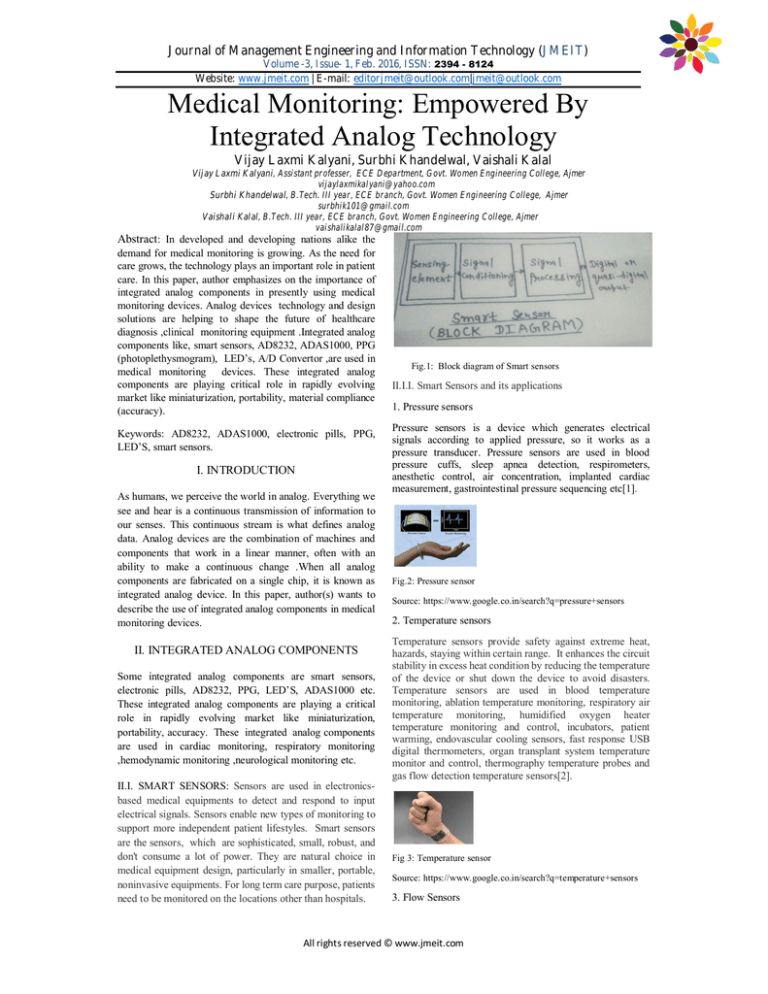
Journal of Management Engineering and Information Technology (JMEIT)
Volume -3, Issue- 1, Feb. 2016, ISSN: 2394 - 8124
Website: www.jmeit.com | E-mail: editorjmeit@outlook.com|jmeit@outlook.com
Medical Monitoring: Empowered By
Integrated Analog Technology
Vijay Laxmi Kalyani, Surbhi Khandelwal, Vaishali Kalal
Vijay Laxmi Kalyani, Assistant professer, ECE Department, Govt. Women Engineering College, Ajmer
vijaylaxmikalyani@yahoo.com
Surbhi Khandelwal, B.Tech. III year, ECE branch, Govt. Women Engineering College, Ajmer
surbhik101@gmail.com
Vaishali Kalal, B.Tech. III year, ECE branch, Govt. Women Engineering College, Ajmer
vaishalikalal87@gmail.com
Abstract: In developed and developing nations alike the
demand for medical monitoring is growing. As the need for
care grows, the technology plays an important role in patient
care. In this paper, author emphasizes on the importance of
integrated analog components in presently using medical
monitoring devices. Analog devices technology and design
solutions are helping to shape the future of healthcare
diagnosis ,clinical monitoring equipment .Integrated analog
components like, smart sensors, AD8232, ADAS1000, PPG
(photoplethysmogram), LED’s, A/D Convertor ,are used in
medical monitoring devices. These integrated analog
components are playing critical role in rapidly evolving
market like miniaturization, portability, material compliance
(accuracy).
Keywords: AD8232, ADAS1000, electronic pills, PPG,
LED’S, smart sensors.
I. INTRODUCTION
As humans, we perceive the world in analog. Everything we
see and hear is a continuous transmission of information to
our senses. This continuous stream is what defines analog
data. Analog devices are the combination of machines and
components that work in a linear manner, often with an
ability to make a continuous change .When all analog
components are fabricated on a single chip, it is known as
integrated analog device. In this paper, author(s) wants to
describe the use of integrated analog components in medical
monitoring devices.
II. INTEGRATED ANALOG COMPONENTS
Some integrated analog components are smart sensors,
electronic pills, AD8232, PPG, LED’S, ADAS1000 etc.
These integrated analog components are playing a critical
role in rapidly evolving market like miniaturization,
portability, accuracy. These integrated analog components
are used in cardiac monitoring, respiratory monitoring
,hemodynamic monitoring ,neurological monitoring etc.
II.I. SMART SENSORS: Sensors are used in electronicsbased medical equipments to detect and respond to input
electrical signals. Sensors enable new types of monitoring to
support more independent patient lifestyles. Smart sensors
are the sensors, which are sophisticated, small, robust, and
don't consume a lot of power. They are natural choice in
medical equipment design, particularly in smaller, portable,
noninvasive equipments. For long term care purpose, patients
need to be monitored on the locations other than hospitals.
Fig.1: Block diagram of Smart sensors
II.I.I. Smart Sensors and its applications
1. Pressure sensors
Pressure sensors is a device which generates electrical
signals according to applied pressure, so it works as a
pressure transducer. Pressure sensors are used in blood
pressure cuffs, sleep apnea detection, respirometers,
anesthetic control, air concentration, implanted cardiac
measurement, gastrointestinal pressure sequencing etc[1].
Fig.2: Pressure sensor
Source: https://www.google.co.in/search?q=pressure+sensors
2. Temperature sensors
Temperature sensors provide safety against extreme heat,
hazards, staying within certain range. It enhances the circuit
stability in excess heat condition by reducing the temperature
of the device or shut down the device to avoid disasters.
Temperature sensors are used in blood temperature
monitoring, ablation temperature monitoring, respiratory air
temperature monitoring, humidified oxygen heater
temperature monitoring and control, incubators, patient
warming, endovascular cooling sensors, fast response USB
digital thermometers, organ transplant system temperature
monitor and control, thermography temperature probes and
gas flow detection temperature sensors[2].
Fig 3: Temperature sensor
Source: https://www.google.co.in/search?q=temperature+sensors
3. Flow Sensors
All rights reserved © www.jmeit.com
Journal of Management Engineering and Information Technology (JMEIT)
Volume -3, Issue- 1, Feb. 2016, ISSN: 2394 - 8124
Website: www.jmeit.com | E-mail: editorjmeit@outlook.com|jmeit@outlook.com
pressure as a disposable sensor, to measure intrauterine
It is the device which senses and record the rate of fluid flow.
pressure during birth, to monitor patient’s vital signs in
It is used in anesthesia delivery machines, oxygen
hospitals and ambulances, to monitor patient breathing, in
concentrators, sleep apnea machines, ventilators, respiratory
eye surgery to control the vaccum level, in kidney dialysis to
monitoring, gas mixing, and electro-surgery. dessication, or
monitor the inlet and outlet pressures of the blood, in drug
destroy tissue such as tumors.
infusion pumps to monitor the flow rate.
Fig 4: Flow sensor
Source: https://www.google.co.in/search?q=flow+sensors
Fig 7: MEMS Sensors
Source: https://www.google.co.in/search?q=MEMS+sensors
4.IMAGE SENSORS
Image sensors are used to see image of entire small intestine
which can help in colon cancer detection. Image sensor
applications include radiography, fluoroscopy, cardiology,
mammography, dental imaging, endoscopy, external
observation, minimally invasive surgery, laboratory
equipment, ocular surgery and observation, and artificial
retinas.
II.II. ELECTRONIC PILL
Fig 5: Image sensor using retina’s image
Fig 8: Microelectronic pill
Source: https://www.google.co.in/search?q=image+sensors
Source:https://www.google.co.in/search?q=electronic+pills+in+me
dical+monitoring
5. BIOSENSORS
Biological sensor is made up of biological elements. The
biological element (may be enzyme, antibody or nucleic acid)
interacts with analyte (a substance, whose constituents are to
be measured) and the biological signal is converted into
electrical signal. It is used in blood glucose, cholesterol
testing, testing for drug misuse. Also it is used in general
healthcare monitoring, screening for diseases, clinical
analysis and diagnosis of disease, veterinary and agricultural
applications, industrial processing and monitoring,
environmental pollution control [3].
Fig 6: Bio sensors measuring blood glucose
Source: https://www.google.co.in/search?q=bio+sensors
When electronic pills travel through the body, it captures the
information like acidity, pressure, temperature levels, images
of esophagus through its tiny camera.
II.II. AD8232
It is an integrated signal conditioning block for ECG use to
extract, amplify and filter small biopotential signals in
presence of noisy conditions, created by motion of
electrode’s placement. The AD8232 is an analogue ECG
amplifier used for low power and body worn applications
[4].The measurement of electrical activity of heart can be
done by ECG (electrocardiogram) also, but in some
conditions, ECG may be extremely noisy. The AD8232
Single Lead Heart Rate Monitor acts as an op amp to help
obtain a clear signals without noise. Operating voltage of
AD8232 is -3.3V. AD8232 is used in remote health
monitoring, biological signal collection, fitness and exercise
heart rate monitoring ,portable ECG.
6. MEMS sensors
The intelligent devices which are connected with MEMS
sensors alert medical professionals when elderly patients
suffer serious injuries from unobserved fall and if the GPS
system is connected with the device, then it will provide
location information also. MEMS sensors collect the
information from the body such as temperature, dissolved
oxygen level and ph level by sampling the body fluid. MEMS
sensors are used in ICU (intensive care unit) to monitor blood
All rights reserved © www.jmeit.com
Journal of Management Engineering and Information Technology (JMEIT)
Volume -3, Issue- 1, Feb. 2016, ISSN: 2394 - 8124
Website: www.jmeit.com | E-mail: editorjmeit@outlook.com|jmeit@outlook.com
Fig 9: AD8232 single lead heart rate monitor
II.IV. LED’S
Another technique for ECG measurement is ADAS1000,
which is also used for respiration. The ADAS1000 is
designed to simplify the task of acquiring and ensuring
quality ECG signals. Its low power and small size make it
suitable for portable, battery powered applications. The high
performance also makes it suitable for higher end diagnostic
machines. It is used in respiration measurement, pace
detection, measurement of ECG signals, bed side patient
monitoring, cardiac defibrillators, patient transport stress
testing, to measure thoracic impedence.
Fig 10: circuit operation of PPG
There are various benefits of using LEDs for medical
applications including longer life, less heat, dynamic control,
lower energy consumption, and in many cases, lower cost.
LED’S are used in surgical lighting, exam lights,
photodynamic therapy, and endoscopy in current integrated
analog devices.
II.IV.I. Applications of LED’S
1.Photodynamic therapy is a cancer treatment method ,that
recently has been improved using LED’S. The
photosensitiser is inserted into the patient’s veins, it
accumulates into tumor cell and then it is activated through
light source and tumor is destroyed which results in free
radical generation followed by cell death.
Fig 12: Photodynamic therapy
source:https://www.google.co.in/search?q=CIRCUIT+OPERATIO
N+OF+ADAS1000
2. Endoscopy
It is used to examine the interior of a hollow organ or cavity
of the body. In endoscopy surgical instruments are inserted
into the body through a cut. The area of interest within the
body is illuminated using a small diameter fiber bundle that
is inserted along with the surgical tools.
II.III. PPG
By illuminating the light on body using LED (light emitting
diode), PPG measures the heart rate with light absorption,
which is either transmitted or reflected using pulse oximeter.
The waveforms of PPG varies with location and also with the
orientation of pulse oximeter. It is used to monitor breathing,
to measure hypovolemia, to measure circulatory conditions,
to measure oxygen saturation in blood(spo2), also used for
volumetric measurement of an organ.
Fig 13: Endoscopy
Source: http://www.wisegeekhealth.com/
3. Surgical light
It is also known as an operating light or surgical lighthead. It
is a medical device intended to assist medical staff during a
surgical procedure by illuminating a local area or cavity of
the patient. A combination of several surgical lights is known
Fig 11: Block diagram of PPG wristband device
All rights reserved © www.jmeit.com
Journal of Management Engineering and Information Technology (JMEIT)
as
a
Volume -3, Issue- 1, Feb. 2016, ISSN: 2394 - 8124
Website: www.jmeit.com | E-mail: editorjmeit@outlook.com|jmeit@outlook.com
electrons, but also to photons and convert either from
“surgical
light
system”
optical to electrical, or electrical to optical, or indeed both.
Phototherapeutic or light therapy innovation is the latest
application of optoelectronics.
The field of phototherapeutics, or light therapy, involves
exposure to light of different wavelengths. This may be very
specific in some cases, or full spectrum in others.
Fig 16: optoelectronic device
III.II. Phototherapy
Fig 14: LED light is integrated into surgical light
Source: https://www.google.co.in/search?q=SURGICAL+LIGHT
4. Exam lights
Exam lights are used for careful examination of patients. A
well illuminated environment improves visibility. All patient
exam room lights are finely crafted and durable to withstand
repeated use. Depending on specific needs, these patients
exam room lights can be used in dermatology, plastic surgery
or general practice.
It is used to treat acne, sleep problems, seasonal affective
disorder (SAD) and minor bacterial and viral conditions.
Phototherapeutic techniques are now being used in an
increasing number of cosmetic procedures, such as wrinkles,
warts, skin rejuvenation and tightening.
III.III. Portal technology
Portal technology allows physicians and patients to access
medical records and interact online. Through this technology
patients become more closely involved and better educated
about their care.
III.IV. In medical monitoring, ultra thin sheets of LED’S and
photodetectors are inserted into the body to activate
photosensitive drugs.
IV. CONCLUSION
Fig 15: exam light
Source: http://www.amico.com/products/lightning-solutions
III.
ADVANCEMENTS
IN
MEDICAL
MONITORING DEVICES USING INTEGRATED
ANALOG COMPONENTS
This paper provided a brief introduction to MEDICAL
MONITORING DEVICES like LED’S,ADC Convertors,
Smart sensors,AD8232 Etc and its advancement in future
direction .It has also described about leading technologies,
identify no. of the opportunities ,as well as some of the
associated challenges. We have reached a point where
wearable medical devices can be designed, built and sold
cheaply enough to improve our quality of life. One of the
reasons this is possible is sensor technology. It is not a new
concept, people in the country are using this technologies.
The purpose of this study is to make people aware about the
leading technologies and advancement in technologies.
III.I. Optoelectronic devices
Applications of optoelectronics are continuously increasing.
The partnership of technology and light inspired the creation
of optoelectronics. It is used for the emission, manipulation
and detection of light. It make use of effect of light on
semiconducting materials. They respond not only to
V. REFERENCES
1. By Robert guzlak “The role of pressure sensors in medical
devices”, sr. Engineering Manager and Lori Appel-Manager,
Marketing Communications, kavilo
All rights reserved © www.jmeit.com
Journal of Management Engineering and Information Technology (JMEIT)
Volume -3, Issue- 1, Feb. 2016, ISSN: 2394 - 8124
Website: www.jmeit.com | E-mail: editorjmeit@outlook.com|jmeit@outlook.com
2. https://www.thermistor.com/medical-temperature-sensors
3.http://www.news-medical.net/health/biosensorapplications.aspx
4. www.mouser.in/..adi-ad8232-amplifier/
VI. Author’s Details
Vijay Laxmi Kalyani is currently working as assistant
professor in the department of ECE in GWECA, Ajmer. She
has attended various workshops, conferences, FDP,STC and
also published various research papers in various
international journals and conferences, Member-IAENG.
Surbhi Khandelwal is pursuing B.Tech.(3rd year) in
Electrical AND Electronics Engineering in GWEC, Ajmer.
Vaishali Kalal is pursuing B.Tech.(3rd year) in Electronics
and communication Engineering in GWEC, Ajmer.
All rights reserved © www.jmeit.com







